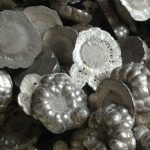Deprecated: get_settings is deprecated since version 2.1.0! Use get_option() instead. in /www/sites/alloy.wiki/index/wp-includes/functions.php on line 4862
Titanium rod barrel burnishing is to grind the parts and abrasives in dilute acid or dilute alkali with emulsifier (or corrosion inhibitor) and follow the rotation of the drum to obtain a bright appearance. It is suitable for the disposal of small parts and parts that are difficult to polish and polish. The correct selection of roller burnishing standards can improve productivity and quality.
1. The shape of the roller
The shape of the roller includes a circle, a hexagon, an octagon, etc., among which a polygon is good for practicality. This is because the radii of the barrel wall from the axis are not equal, and there is a certain point of view, so the rolling parts are easy to change the position, the chance of collision with each other increases, the grinding is uniform, and the efficiency is high, which can shorten the rolling time.
2, the scale of the drum
The straight adjustment is 50mm-100mm, and the length varies with the number of grids. The length of the first pattern roller is 600-800mm; the second pattern is 800-1500mm. Usually the larger one is better. This is because the parts are subjected to high pressure and friction in the drum, so the amount of cutting is also increased. But for those parts that are afraid of being stressed and easily deformed, a small roller can be used and the length of the roller can be increased.
1) Materials for roller
There is a direct relationship between the drum rotation speed and the scraping amount of the parts within a certain range, that is, the faster the rotation speed, the greater the scraping of the metal surface. However, when the speed exceeds a certain upper limit, it drops instead. Because when the rotating speed is too fast, the centrifugal force of the parts in the drum increases, which reduces the friction. Usually it is appropriate to control at 45r/min.
2) Abrasives and solutions for barrel polishing
The abrasives for rolling include pumice, quartz, granite skin angle, shells, iron filings and ceramic fragments. The size of the abrasive particles should be larger or smaller than each hole of the Cen part. The amount of content in the drum is also an important factor affecting the quality of the agricultural surface of the parts. The amount of people inside the drum is usually 70% of the drum volume. Regarding the heavier titanium parts or threaded parts, the load should be controlled at 80%-90%. The solution in the drum should be added to about 95% of the drum volume (note: when adding acidic solution to the drum, you should first add enough water, and then add acid, to avoid corrosion of parts in the rolling process, because of the increase in time , The concentration of the built-in solution gradually decreases, or even loses its effect. Therefore, the concentration of the solution should be checked and replaced at regular intervals. The burn-in time should not be too long, otherwise the parts will be damaged. That is, use a brush to remove the surface of the parts. Burrs, terbium compounds, remaining oil and corrosion sludge, etc., and make the parts have a certain luster. Be sure to point out that elastic, rigid or thin-walled parts should be taken out in time after the finishing of rolling, otherwise it will easily cause hydrogen seepage or local over-corrosion .
Link to this article:Electrochemical polishing of titanium rods, titanium alloy rods, and TC4 titanium rods
Reprint Statement: If there are no special instructions, all articles on this site are original. Please indicate the source for reprinting:Alloy Wiki,thanks!^^


